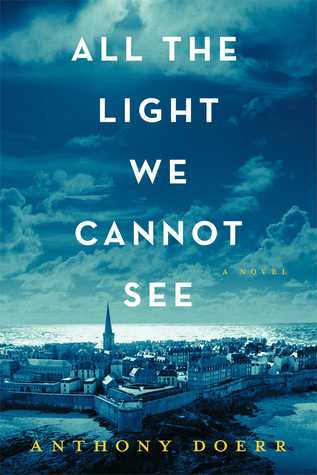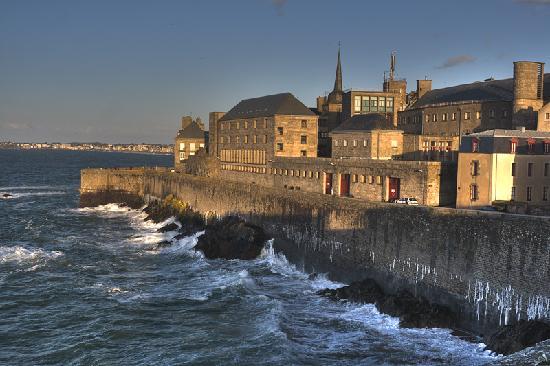
All the Light We Cannot See, Anthony Doerr’s lovely new novel, interweaves the stories of Marie-Laure, a blind French girl, and Werner, an orphan who gets pulled into an academy for Hitler Youth. The book, written in short, elegant chapters, moves back and forth between these two narratives with the landscape of WWII always looming in the backdrop. With its unique structure and stunning descriptions, All the Light We Cannot See explores this vivid world, and is ultimately about the big and small moments that bring us together.
I first encountered Doerr’s work a decade ago when I picked up a copy of The Shell Collector at a small bookstore in Seattle. I carried the book to a nearby coffee shop and spent the rainy afternoon reading it. I had recently graduated college, and I’m not sure if it was my uncertain future or the gloomy day, but this collection of stories had a profound effect on me. I found a precise kind of truth within those pages—the kind that captures human experience in only the way perfectly crafted stories can. I reveled in those wonderful sentences that afternoon, and since then I have always looked forward to reading Doerr’s work.
His books are wide-ranging—in both content and style—and always surprising. His inventive novel, About Grace, follows a hydrologist who has dreams that sometimes come true in the future. His next book, Four Seasons in Rome, is a memoir about a year spent in Rome with his family. Memory Wall, another dazzling and beautifully strange collection—of which the title story happens to be one of my all-time favorite pieces of writing—brings us a whole range of rich landscapes, from South Africa to Lithuania to China. All the Light We Cannot See is a book that was ten years in the making, and it is a remarkable novel, but perhaps more than anything, it has reminded me of Doerr’s extraordinary ability to bring together the elements—rhythm and imagery and tone—to somehow perfectly capture the most mysterious parts of our experience—love and fear and fate—with something so simple as a sentence.
***
The Rumpus: One of the things I noticed right away about All the Light We Cannot See is its distinctive style. It’s quite different from anything you’ve written before, and the structure is really captivating. Can you talk about how/why you structured the book this way?
Anthony Doerr: Thank you, Nancy! I’ve been building up to this structure for a while, trying it out in various shorter forms. I started playing around with brief, titled sections in a short story about the Three Gorges Dam called “Village 113” back in 2005. “Memory Wall” was the next progression: a novella told in short sections, each with a title, and this time the narrator roved between characters, as it does in All the Light.
The little segments present a way for me to be obsessive—if I only have a few hours, I can read through one, revise and try to improve it. I loved how little pocket-chapters offer me a chance to make small, manageable miniatures that I can refine and purify, then string together into strands to tell a story.
But you’re right in many ways: this is the first time I tried a strictly binary structure—A-B-A-B-A-B, Marie-Werner-Marie-Werner—on such a large scale, oscillating back and forth between two protagonists in a kind of bilateral symmetry. I found that by suspending one narrative for a few pages and returning to the other, it generated some old-fashioned narrative momentum because a reader was left in suspense, wanting to know what was happening to the character we’d left. I also loved organizing the chapters in groups and seeing what kinds of patterns I could make.
Finally, I think this structure is a way to give a reader breathing room. I’m asking a reader to follow two adolescents here, through a lot of places and timelines, so I wanted her to be able to take a breath between chapters—to see some white space and be able to let down for a moment before falling back in.
Rumpus: As I was reading, the landscape of the book really became a deep part of the story for me, almost as much as the characters. Some of my favorite moments in the book were the beautiful descriptions of Saint-Malo. What were you trying to capture about this particular space and time?
Doerr: The first time I saw Saint-Malo, I fell in love with the city. It was night, and low tide, and I was walking on the ramparts that surround the town, and somehow the combined effects of jet lag, ocean wind, fatigue, and three glasses of Muscadet all made me wonder if I might be dreaming. I felt as though I was walking through an imaginary city, a place that was part-fairy tale fortress, part-M.C. Escher drawing, part-mist and granite and lamplight. A place surrounded by nature and yet bulwarked against it.
So I wanted to capture the town’s otherworldliness, the sense that it’s almost a place of fantasy as much as reality. The novel is influenced in lots of subconscious ways by fairy tales (Werner and Jutta are little snowy-haired children in a bottomland of soot, Volkheimer is a kind of ogre, Marie-Laure is a girl without sight who sees more than anyone else, etc.) and Saint-Malo seemed like the perfect island fortress in which to set the culminating scenes of a fairy tale: a real place, with a real history, sure, but also a place of the imagination.
Rumpus: How did you go about researching this novel? Obviously there are certain historical facts that may shape the narrative. How did you balance this with creating a fictional world?
Doerr: I went to Europe three times, I read dozens and dozens of books, I studied thousands of photos. But I always supplemented that research with imagination; research might give you detail, but imagination supplies the direction in which to apply all that detail. For me, writing historical fiction is all about finding a balance between reading, traveling, looking, imagining, and dreaming. (And procrastinating.)
Rumpus: Something I always notice in your writing is a very careful attention to detail, especially around technical activities. In All the Light We Cannot See, one of the major components of the book is radio and Werner’s ability to fix machines. What do you find interesting about the use of radio in this time?
Doerr: Ooh, I find everything about it interesting! Radio—and perhaps airplanes, and then of course, the atom bomb—was the preeminent technology of the first half of the 20th century. It was how the Third Reich controlled its citizens, spread lies, and disseminated fear. And radio was also a tool for Allied propaganda, for resistance, for liberation. It was how larger political and artistic narratives entered the homes of people, and it held power over children in much the way tablets and smartphones hold power over children now.
One of the great projects of this novel was to conjure a time when radio—when hearing the voice of a stranger, or a distant loved one, in your ear—was still a miracle. So, yep, I tried to throw myself into the language, poetry, and technical detail of pre-transistor radios. And at the end of the novel I tried to conjure up an image of all the invisible light that’s flying around us all the time now, text messages, phone calls, advertisements…the air brims with communication carried by invisible light.
Rumpus: The book deals with time in a very interesting way. I think this is connected, in part, to the structure and the short chapters, which move back and forth through time. But there is also a wonderful sense of movement throughout the book, both on a small scale within individual moments, but also on a bigger scale across the entire book. Can you talk a bit about how the story moves and what the role of time is in the book?
Doerr: WWII is something contemporary readers already know a lot about. If our schools are doing their jobs, they know about the invasion of Normandy, the Hitler Youth, the Holocaust, and at least a few of the horrors of the Eastern Front. So in terms of the larger historical movement, most readers already intuit what’s coming in this novel. They know the Germans will be driven out of coastal France, and they’ll probably know that it will cost a lot of human lives to do so.
So I decided to acknowledge that foreknowledge as soon as the book started. That’s really why I begin the story in 1944, before backtracking into Werner’s and Marie’s childhoods, in order to say to a reader: I know you know what’s coming. In a sense I tried to hang those American bombs, suspended, over the next three or four hundred pages of narrative.
Then I tried to bring both the front story—Werner’s and Marie’s fates during the siege of Saint-Malo, and the backstory—Werner’s and Marie’s fates leading up to the siege—to a climax at the same time. The goal was to try to make a reader feel that a lot of threads were braiding together all at once.
Rumpus: Marie-Laure, one of the main characters, is blind. Throughout the book I felt I was connected to her world via touch and texture, and of course the model city that she uses for reference. This is a bit unusual in fiction, as we often connect via the descriptions of visual things, perhaps more than tangible things. What were you thinking about when you crafted Marie-Laure’s sensory experience? How can we capture the senses in writing?
Doerr: For me good fiction writing is all about transporting the reader, and my favorite novelists—Flaubert, Tolstoy, Woolf, Cormac McCarthy—all use senses beyond the visual to airlift me out of my own life and into someone else’s. In Marie’s sections, I made a challenge for myself in that I couldn’t rely as heavily on visual detail, but I tried to make up for that by rendering her world as fully and richly and colorfully as possible. The only way I knew how to do that was to go slowly, and to breathe, and to pay as much attention as I could to the experience of being alive. I figure: as fiction writers, we get to use smells and sounds and textures and thought patterns in ways that filmmakers cannot, so why not use them?
Rumpus: Lastly, I have to ask, what have you been reading lately? Since you happen to live in my hometown of Boise, can you recommend any favorite Idaho authors?
Doerr: Let’s see: I’m reading Madness, Rack, and Honey, an amazing and fascinating and strange collection of essays by Mary Ruefle. Favorite Idaho authors: Denis Johnson and Marilynne Robinson, if we can claim her. I love Brady Udall’s novels and stories; he lives just down the street. Kim Barnes rules. And I think Alan Heathcock’s collection Volt is an electrifying book.






